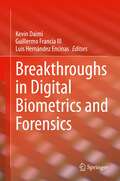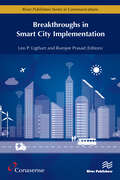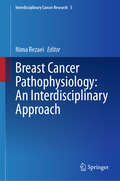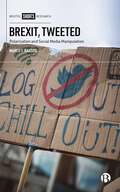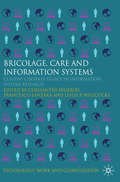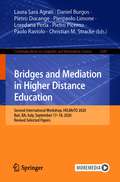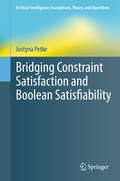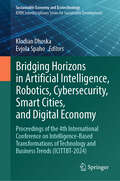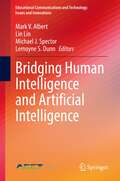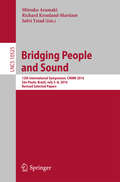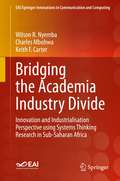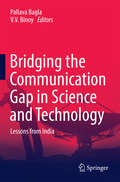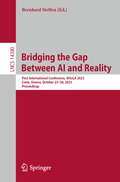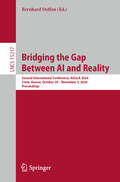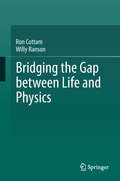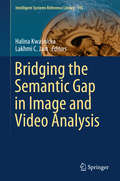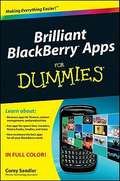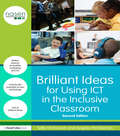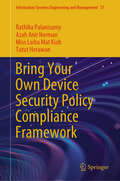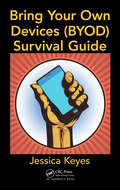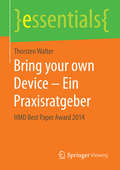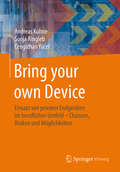- Table View
- List View
Breakthroughs in Digital Biometrics and Forensics
by Luis Hernández Encinas Kevin Daimi Guillermo FranciaThis book focuses on a wide range of breakthroughs related to digital biometrics and forensics. The authors introduce the concepts, techniques, methods, approaches and trends needed by cybersecurity specialists and educators for keeping current their biometrics and forensics knowledge. Furthermore, the book provides a glimpse of future directions where biometrics and forensics techniques, policies, applications, and theories are headed. Topics include multimodal biometrics, soft biometrics, mobile biometrics, vehicle biometrics, vehicle forensics, integrity verification of digital content, people identification, biometric-based cybercrime investigation, among others. The book is a rich collection of carefully selected and reviewed manuscripts written by diverse digital biometrics and forensics experts in the listed fields and edited by prominent biometrics and forensics researchers and specialists.
Breakthroughs in Smart City Implementation (River Publishers Series In Communications Ser.)
by Ramjee Prasad Leo P. LigthartBreakthroughs in Smart City Implementation should give answers on a wide variety of present social, political and technological problems. Green and long-lasting solutions are needed in coming 10 years and beyond on areas as green and long lasting solutions for improving air quality, quality of life of residents in cities, traffic congestions and many more.Two Conasense branches, established in China and in India, report in six book chapters on initiatives needed to overcome the obvious shortcomings at present. Three more chapters complete this fifth Conasense book: an introductory chapter concerning Smart City from Conasense perspective, a chapter showing that not technology but the people in the cities are most important and a chapter on recent results and prospects of “Human in the Loop” in smart vehicular systems.
Breast Cancer Pathophysiology: An Interdisciplinary Approach (Interdisciplinary Cancer Research #5)
by Nima RezaeiBreast cancer is one of the most prevalent malignancies worldwide, particularly in females, with a high rate of cancer-related deaths globally. Increasing age, obesity, harmful use of alcohol, family history of breast cancer, starting age of menstrual periods, and tobacco use are some of the risk factors for breast cancer. The fifth volume of the “Interdisciplinary Cancer Research” series, entitled “Breast Cancer Pathophysiology: An Interdisciplinary Approach” publishes comprehensive volumes on the mechanisms of breast cancer, early detection, assessment, and patient outcome. The role of defective estrogen signals, membrane estrogen receptor, and dietary polyunsaturated fatty acids in breast cancer are also presented in this volume. This interdisciplinary series is of special value to researchers working on cell biology, immunology, biochemistry, genetics, and practitioners working on oncology. This is the main concept of Cancer Immunology Project (CIP), which is a part of Universal Scientific Education and Research Network (USERN). This interdisciplinary book will be of special value to researchers, oncologists, and oncosurgeons who wish to extend their knowledge on breast cancer.
Brexit, Tweeted: Polarization and Social Media Manipulation
by Marco BastosDissecting 45 million tweets from the period that followed the Brexit referendum, this book presents an extensive analysis of social media manipulation. The book examines emerging changes in partisan politics, nationalist and populist values, as well as broader societal changes that are feeding into polarization and echo-chamber communication. It pulls the curtain back on the techniques employed to interfere with, and potentially distort, the public discussion. Making complex data accessible to non-technical audiences, this unique post-mortem of the Brexit referendum contributes to our understanding of social media disinformation in the UK and beyond.
Brick & Mortar Shopping in the 21st Century
by Tina M. LowreyThis book explores how traditional retailing operates in the new competitive environment of a combined e-tailing and brick and mortar marketplace. In drawing together the cutting-edge research of a global group of experts in the field of consumer behavior, this volume addresses questions such as: which psychological theories can provide insights in
Bricolage, Care and Information: Claudio Ciborra's Legacy in Information Systems Research (Technology, Work and Globalization)
by Giovan Francesco Lanzara Leslie P. Willcocks Chrisanthi AvgerouClaudio Ciborra was one of the most innovative thinkers in the field of information systems. This book explains the intellectual contribution of Ciborra's work in a substantial introductory chapter, contains the most significant of his articles, and provides a sample of research that draws from his ideas.
Bridges and Mediation in Higher Distance Education: Second International Workshop, HELMeTO 2020, Bari, BA, Italy, September 17–18, 2020, Revised Selected Papers (Communications in Computer and Information Science #1344)
by Daniel Burgos Pietro Ducange Pietro Picerno Paolo Raviolo Christian M. Stracke Laura Sara Agrati Pierpaolo Limone Loredana PerlaThis book constitutes the thoroughly refereed post-conference proceedings of the Second International Workshop on Higher Education Learning Methodologies and Technologies Online, HELMeTO 2020, held in Bari, Italy, September 2020. Due to the COVID-19 pandemic the conference was held online. The 25 revised full papers and 3 short papers presented were carefully reviewed and selected from a total of 59 submissions. The papers present recent research on challenges of implementing emerging technology solution for online, online learning pedagogical frameworks, facing COVID19 emergency in higher education teaching and learning, online learning technologies in practice, online learning strategies and resources, etc.
Bridging Constraint Satisfaction and Boolean Satisfiability (Artificial Intelligence: Foundations, Theory, and Algorithms)
by Justyna PetkeThis book provides a significant step towards bridging the areas of Boolean satisfiability and constraint satisfaction by answering the question why SAT-solvers are efficient on certain classes of CSP instances which are hard to solve for standard constraint solvers. The author also gives theoretical reasons for choosing a particular SAT encoding for several important classes of CSP instances. Boolean satisfiability and constraint satisfaction emerged independently as new fields of computer science, and different solving techniques have become standard for problem solving in the two areas. Even though any propositional formula (SAT) can be viewed as an instance of the general constraint satisfaction problem (CSP), the implications of this connection have only been studied in the last few years. The book will be useful for researchers and graduate students in artificial intelligence and theoretical computer science.
Bridging Horizons in Artificial Intelligence, Robotics, Cybersecurity, Smart Cities, and Digital Economy: Proceedings of the 4th International Conference on Intelligence-Based Transformations of Technology and Business Trends (ICITTBT-2024) (Sustainable Economy and Ecotechnology)
by Evjola Spaho Klodian DhoskaThis book aims to foster interdisciplinary research among industry and academic participants and form long-term strategic links. It provides a presentation of new knowledge and development through the exchange of practical experience between industry, scientific institutes and business. The carefully selected conference themes have been chosen to engender these in the fields of engineering, industry, information technology, business, economics and finance, and applied sciences. This book aims to provide the latest research findings, innovative research results, methods and development techniques from both theoretical and practical perspectives related to the emerging areas of artificial intelligence, cybersecurity, robotics and automation, smart technologies, data analytics and data science, network and communication, cloud and mobile computing, Internet of things, virtual augmented and mixed reality, technology in applied science, digital economy, management and business, finance and accounting, statistics and econometrics, economics and social sciences.
Bridging Human Intelligence and Artificial Intelligence (Educational Communications and Technology: Issues and Innovations)
by Lin Lin Michael J. Spector Mark V. Albert Lemoyne S. DunnThis edited volume is based on contributions from the TCET-AECT “Human-Technology Frontier: Understanding the Learning of Now to Prepare for the Work of the Future Symposium” held in Denton, Texas on May 16-18, sponsored by AECT. The authors embrace an integrative approach to designing and implementing advances technologies in learning and instruction, and focus on the emerging themes of artificial intelligence, human-computer interactions, and the resulting instructional design. The volume will be divided into four parts: (1) Trends and future in learning and learning technologies expected in the next 10 years; (2) Technologies likely to have a significant impact on learning in the next 10 years; (3) Challenges that will need to be addressed and resolved in order to achieve significant and sustained improvement in learning; and (4) Reflections and insights from the Symposium that should be pursued and that can form the basis for productive research collaborations. The primary audience for this volume is academics and researchers in disciplines such as artificial intelligence, cognitive science, computer science, educational psychology, instructional design, human-computer interactions, information science, library science, and technology integration.
Bridging People and Sound: 12th International Symposium, CMMR 2016, São Paulo, Brazil, July 5–8, 2016, Revised Selected Papers (Lecture Notes in Computer Science #10525)
by Mitsuko Aramaki Richard Kronland-Martinet Sølvi YstadThis book constitutes the thoroughly refereed post-conference of the 12th International Symposium on Computer Music Modeling and Retrieval, CMMR 2016, held in S#65533;o Paulo, Brazil, in July 2016. The 22 full papers presented were carefully reviewed and selected from 40 submissions. This year's conference theme "Bridging People and Sound" aimed at encouraging contributions from artists and listeners on the one side and audio and music technology researchers on the other.
Bridging the Academia Industry Divide: Innovation and Industrialisation Perspective using Systems Thinking Research in Sub-Saharan Africa (EAI/Springer Innovations in Communication and Computing)
by Charles Mbohwa Wilson R. Nyemba Keith F. CarterThis book is the result of years of research following a realization of the mismatch of engineering skills produced by universities and those that industry required, based on the situation in Sub-Saharan Africa, equally applicable to other regions in Africa and indeed worldwide. The book is meant to assist engineering academics and engineers in industry to build capacity and cope with the dynamic trends in technology brought on by the 4th Industrial Revolution and to prepare for the 5th Industrial Revolution, an era predicted to be dominated by critical and system thinkers with creative and innovative skills as basic necessities. The book is also useful for policy-making researchers in academia, industrial and public sector researchers, and implementers in governments that provide required funding for the development of human resources and skills. The book primarily consists of the novel research and innovation approaches of modelling and building systems thinking sub-models which were ultimately integrated into the Universal Systems Thinking (UST) model aimed at improving the quality of engineers and engineering practice. The initiatives in this book include strategies for bridging the gap between industry and academia through systems thinking research. The book provides information on how to model, simulate, adjust and implement integrated systems thinking approaches to engineering education and training for capacity building and sustainability. The book also covers approaches to address research gaps and mismatch of skills while capitalizing on the successes of several projects carried out and supported by the Royal Academy of Engineering over the years.
Bridging the Communication Gap in Science and Technology: Lessons from India
by Pallava Bagla V. V. BinoyThis first-of-a-kind volume provides a snapshot of existing science communication policy and practice in India across different S&T sectors, and offers solutions to building effective communication. It provides an understanding on how to avoid societal clashes in situations when science meets the public in these sectors. The editors and contributors argue that effective S&T communication leads not only to a more informed public but also benefits research itself, and in a changing society like India this is a crucial element related to good governance and policy making. In this volume, experienced masters of the craft provide practical solutions to making S&T communication more effective in a vast democracy like India, which has complex issues related to literacy levels, diverse languages, varying political will, reach, and resources. Through, discussions on cases of creating information modules for the public on the Internet, television and radio, social media, as well as traditional ways of outreach like people's science movements, holding popular science events, and fairs, the volume provides highly valuable directions on how developing countries with low resources and complex populations can communicate S&T research to the public and bridge communication gaps. This volume will interest researchers from science, social science, mass communication and public relations departments, journalists, as well as practitioners and policy makers from government and non-government institutions involved in S&T policy, practice and communication and people who want to understand the complex S&T landscape of India.
Bridging the Digital Divide in the US: Planning Innovative State and Local Approaches (Community Development Research and Practice Series)
by Mildred E. Warner Natassia A. Bravo Duxixi ShenThe US faces a deep digital divide which cuts across both urban and rural lines, but is most marked in rural, low income, and minority communities. This book presents a multi-level governance framework which explores how local leaders use policy opportunity and community resilience to address inequity in broadband infrastructure. Cases from communities across the US are profiled to show how local and regional initiatives address the digital divide – how they harness local resources, state and federal funding, and how they navigate regulatory restrictions and financial constraints. Special attention is given to rural and Indigenous communities, where the technological, organizational, and funding challenges are greatest. The federal policy landscape for broadband is changing, and this book provides clear insights on how policy can support the people and places left behind. This book is essential for planners and those studying or working in rural development, rural studies, and community development.The Open Access version of this book, available at www.taylorfrancis.com, has been made available under a Creative Commons Attribution-Non Commercial (CC-BY-NC) 4.0 license.
Bridging the Gap Between AI and Reality: First International Conference, AISoLA 2023, Crete, Greece, October 23–28, 2023, Proceedings (Lecture Notes in Computer Science #14380)
by Bernhard SteffenThis book constitutes the proceedings of the First International Conference on Bridging the Gap between AI and Reality, AISoLA 2023, which took place in Crete, Greece, in October 2023. The papers included in this book focus on the following topics: The nature of AI-based systems; ethical, economic and legal implications of AI-systems in practice; ways to make controlled use of AI via the various kinds of formal methods-based validation techniques; dedicated applications scenarios which may allow certain levels of assistance; and education in times of deep learning.
Bridging the Gap Between AI and Reality: First International Conference, AISoLA 2023, Crete, Greece, October 23–28, 2023, Selected Papers (Lecture Notes in Computer Science #14129)
by Bernhard SteffenThis open access book constitutes revised selected papers from the First International Conference on Bridging the Gap between AI and Reality, AISoLA 2023, which took place in Crete, Greece, in October 2023. The papers included in this book focus on the following topics: The nature of AI-based systems; ethical, economic and legal implications of AI-systems in practice; ways to make controlled use of AI via the various kinds of formal methods-based validation techniques; dedicated applications scenarios which may allow certain levels of assistance; and education in times of deep learning.
Bridging the Gap Between AI and Reality: Second International Conference, AISoLA 2024, Crete, Greece, October 30 – November 3, 2024, Proceedings (Lecture Notes in Computer Science #15217)
by Bernhard SteffenThis book constitutes the proceedings of the Second International Conference on Bridging the Gap between AI and Reality, AISoLA 2024, which took place in Crete, Greece, in October/November 2024. The papers included in this book focus on the following topics: AI assisted programming; digital humanities; approaches of using formal methods and ai in health care; models for trustworthy autonomous systems; responsible and trusted AI; safe autonomous vehicles; statistical model checking; verification and learning for assured autonomy; verification for neuro-symbolic artificial intelligence.
Bridging the Gap between Life and Physics
by Ron Cottam Willy RansonThis is the only book which deals with the correlatory comparison between hierarchical living systems and inorganic physical ones. The culmination of the book is the proposition of research to discover and understand the natural underlying level of organization which produces the descriptive commonality of life and physics. Traditional science eliminates life from its purview by its rejection of interrelationships as a primary content of systems. The conventional procedure of science is that of reductionism, whereby complex systems are dismantled to characterize lower level components, but virtually no attention is given to how to rebuild those systems—the underlying assumption is that analysis and synthesis are symmetrical. This book fulfills two main coupled functions. Firstly, it details hierarchy as the major formulation of natural complex systems and investigates the fundamental character of natural hierarchy as a widely transferable ‘container’ of structure and/or function – and this in the case of the new development of a representational or model hierarchy. Secondly, it couples this hierarchical description to that of the electronic properties of semiconductors, as a well-modeled canonical example of physical properties. The central thesis is that these two descriptions are comparable, if care is taken to treat logical and epistemological aspects with prudence: a large part of the book is composed of just this aspect of care for grounding consistency. As such great attention is given to correct assessment of argumentative features which are otherwise presumed ‘known’ but which are usually left uncertain. Development of the ideas is always based on a relationship between entity or phenomenon and their associated ecosystems, and this applies equally well to the consequent derivations of consciousness and information.
Bridging the Semantic Gap in Image and Video Analysis (Intelligent Systems Reference Library #145)
by Lakhmi C. Jain Halina KwaśnickaThis book presents cutting-edge research on various ways to bridge the semantic gap in image and video analysis. The respective chapters address different stages of image processing, revealing that the first step is a future extraction, the second is a segmentation process, the third is object recognition, and the fourth and last involve the semantic interpretation of the image.The semantic gap is a challenging area of research, and describes the difference between low-level features extracted from the image and the high-level semantic meanings that people can derive from the image. The result greatly depends on lower level vision techniques, such as feature selection, segmentation, object recognition, and so on. The use of deep models has freed humans from manually selecting and extracting the set of features. Deep learning does this automatically, developing more abstract features at the successive levels. The book offers a valuable resource for researchers, practitioners, students and professors in Computer Engineering, Computer Science and related fields whose work involves images, video analysis, image interpretation and so on.
Brilliant BlackBerry Apps For Dummies
by Corey SandlerEnhance your BlackBerry app user experience with this full-color guide!With hundreds of thousands of BlackBerry apps available for business users on the go, how do you even begin to filter through them to find the ones that best suit your needs? You don't have to--Brilliant BlackBerry Apps For Dummies does the work for you! This exciting full-color guide covers hundreds of the best, most essential, and most effective applications conducive to bolstering your productivity and enhancing your BlackBerry user experience. Discover which apps can put a world of information at your fingertips!Filters through hundreds of thousands of BlackBerry applications to present you with the ones that will serve you bestProvides the lowdown on the most essential apps for increasing your productivity and enhancing your BlackBerry experienceReveals tips and tricks for getting the most out of each application and customizing your BlackBerry to suit your needsSaves you time and effort by doing the research for you and providing you with the best apps in the areas of business, finance, reference, sports, travel, social networking, entertainment, news, food, nutrition, games, fitness, and moreBrilliant BlackBerry Apps For Dummies removes the pits and filters out the seeds to present you with the best BlackBerry apps for increased productivity on the go!
Brilliant Ideas for Using ICT in the Inclusive Classroom (David Fulton / Nasen Ser.)
by Sally McKeown Angela McGlashonRunner up in Teach Secondary’s Technology and Innovation Awards 2014 sponsored by Lego, Brilliant Ideas for using ICT in the Inclusive Classroom provides lots of simple practical ideas showing teachers and support staff how they can use ICT to boost the achievement of all pupils. How can you use ICT to boost the achievement of all your pupils? This practical teachers’ guide will help you to unlock the enormous potential of new technology in order to enhance pupils’ learning, particularly for young people with additional needs. Written by two of the UK’s leading technology experts, this invaluable and newly updated resource will enable you to use ICT effectively to make lessons more accessible, motivating and fun. With fifty illustrated case studies and twenty starter activities, this practical resource will help you to introduce new technology into the inclusive classroom. It has been specifically designed to help develop your pupils’ key skills, such as problem solving, developing concepts and communicating to different audiences. In each activity, the authors show why and how a particular resource was used and show how similar techniques can be implemented to open up the curriculum to your learners. The authors include timely and realistic advice on how to use a range of technologies from the cheap and cheerful – and even free – to more sophisticated and specialist packages. Find out about: Apps Blogging Digital animation Podcasting Digital storytelling Wikis Geocaching Coding Games and gaming Sat nav Art packages Twitter Whether you’re already techno-savvy or looking to get started with ICT, this book is full of brilliant ideas on how to engage learners of all abilities using technology. If you’re looking for inspiration on how to integrate creative uses of ICT with the curriculum, this book will prove invaluable.
Bring Your Own Device Security Policy Compliance Framework (Information Systems Engineering and Management #37)
by Tutut Herawan Rathika Palanisamy Azah Anir Norman Miss Laiha KiahProliferation of Bring Your Own Device (BYOD) has instigated a widespread change, fast outpacing the security strategies deployed by organizations. The influx of these devices has created information security challenges within organizations, further exacerbated with employees&’ inconsistent adherence with BYOD security policy. To prevent information security breaches, compliance with BYOD security policy and procedures is vital. This book aims to investigate the factors that determine employees' BYOD security policy compliance by using mixed methods approach. Security policy compliance factors, BYOD practices and security risks were identified following a systematic review approach. Building on Organizational Control Theory, Security Culture and Social Cognitive Theory, a research framework positing a set of plausible factors determining BYOD security policy compliance was developed. Next, with a purposive sample of eight information security experts from selected public sector organizations, interviews and BYOD risk assessments analysis were performed to furnish in-depth insights into BYOD risks, its impact on organizations and recommend control measures to overcome them. This led to the suggestion of four control measures to mitigate critical BYOD security risks such as Security Training and Awareness (SETA), policy, top management commitment and technical countermeasures. The control measures were mapped into the research framework to be tested in the following quantitative phase. The proposed research framework was tested using survey results from 346 employees of three Critical National Information Infrastructure (CNII) agencies. Using Partial Least Squares – Structural Equation Modelling (PLS-SEM), the framework's validity and reliability were evaluated, and hypotheses were tested. Findings show that perceived mandatoriness, self-efficacy and psychological ownership are influential in predicting employees&’ BYOD security policy compliance. Specification of security policy is associated with perceived mandatoriness, while BYOD IT support and SETA are significant towards self-efficacy. Unexpectedly, security culture has been found to have no significant relationship to BYOD security policy compliance. Theoretical, practical, and methodological contributions were discussed and suggestions for future research were recommended. The analysis led to a number of insightful findings that contribute to the literature and the management, which are predominantly centered on traditional computing. In view of the ever-increasing BYOD threats to the security of government information, it is imperative that IT managers establish and implement effective policies to protect vital information assets. Consequently, the findings of this study may benefit policymakers, particularly in the public sector, in their efforts to increase BYOD security policy compliance among employees.
Bring Your Own Devices (BYOD) Survival Guide
by Jessica KeyesWhere end-users once queued up to ask the IT department for permission to buy a new computer or a new version of software, they are now bypassing IT altogether and buying it on their own. From laptops and smartphones to iPads and virtually unlimited software apps, end-users have tasted their freedom and love it. IT will simply never be the same.Bri
Bring your own Device - Ein Praxisratgeber: HMD Best Paper Award 2014 (essentials)
by Thorsten WalterThorsten Walter beschreibt die technischen und juristischen Fallstricke sogenannter ,,Bring your own device"-Modelle und stellt die arbeitsrechtlichen Regelungsinstrumente für den Umgang mit BYOD vor. Darüber hinaus werden die verschiedenen technischen Lösungen zur Umsetzung von BYOD im Unternehmen in leicht verständlicher Form einander gegenübergestellt. Der Autor gibt praktische Empfehlungen zur Gestaltung von Regelungen in Nutzungsvereinbarungen.
Bring your own Device: Einsatz von privaten Endgeräten im beruflichen Umfeld – Chancen, Risiken und Möglichkeiten
by Andreas Kohne Sonja Ringleb Cengizhan YücelDas Buch betrachtet das Thema BYOD (Bring your own Device) ganzheitlich - ausgehend von einer Mobile-Strategie im Unternehmen werden alle relevanten Aspekte wie rechtliche Rahmenbedingungen, Sicherheitsrisiken und deren Behandlung, technische Voraussetzungen (Software, IT-Infrastruktur, Support), Einführungs- und Betriebskosten, Erreichbarkeit und Collaboration sowie soziale Aspekte, Unternehmenspolitik und die Implementierung von BYOD beleuchtet. Damit wird dem zunehmenden Trend zur Nutzung von privaten, mobilen Endgeräten im beruflichen Umfeld Rechnung getragen. Praxisnah befassen sich die Autoren mit Problemen und Fragestellungen rund um die Integration von privaten Endgeräten in die IT-Infrastruktur des Arbeitgebers und liefern konkrete Herangehensweisen, Empfehlungen und Best-Practices für die Planung, Prüfung und Umsetzung einer BYOD -Strategie. Das Buch hilft allen, die eine Einführung von BYOD in ihrem Betrieb prüfen, zu einem umfassenden Verständnis von Chancen und möglichen Risiken, aber auch von Alternativen zu gelangen.
